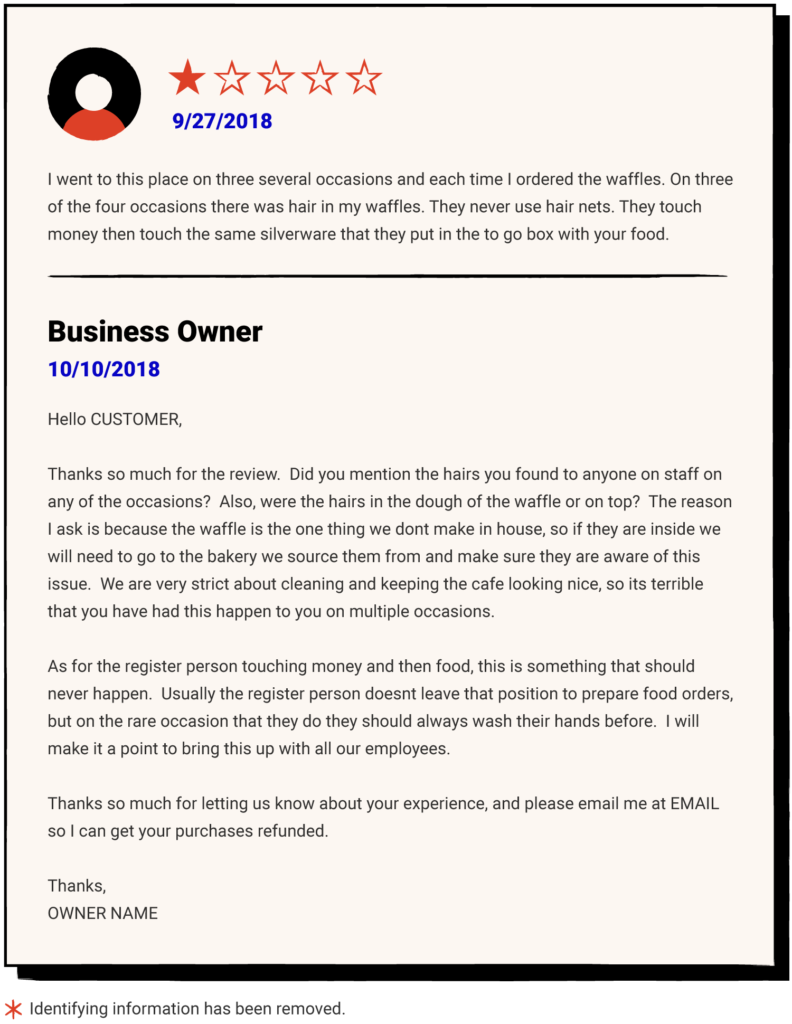By Kristina Aguirre, Contributor
Reviews are essential for today’s restaurants and bars. Many customers look at reviews first before deciding on where they’ll dine for the night. We all know it’s important to get your favorite guests to leave reviews, but what do we do when a few bad ones roll in?
No, you shouldn’t ignore them. You also shouldn’t defensively fire back at the reviewer. Instead, you need to respond to your bad reviews with a level head and a slice of humble pie.
It’s not easy to respond to someone who points out your flaws or uses their review to exaggerate a minor inconvenience. However, we’re going to walk you through a few steps you can take to make the review management process a little less frustrating.
Walk Away
Responding right away is important, but that doesn’t mean you should respond before you’ve cleared your head. Negative reviews are frustrating at times when you know you could’ve fixed the issue on the spot. They’re even more frustrating if you find that the reviewer is exaggerating or lying.
Don’t let a bad review get under your skin. It can push you to say something that gives that customer and others a bad impression of you. Instead, take a moment to breathe so you can objectively read through the review.
Respond ASAP
Juggling all of the responsibilities of a restaurant is tough, especially when you don’t have a ton of staff to help with things like marketing. Unfortunately, not many guests stop to think about this when reading through your reviews. BrightLocal found that 26% of customers expect businesses to respond to reviews within two days.
That’s not a lot of wiggle room. If you’re busy throughout the week, pick a couple days and times where you can knock out review responses. It’s tedious, but it’ll be worth it in the long run when you reconcile with upset customers and reassure others who read your reviews.
If you can’t carve out some time, ask someone on your staff for help. You can also hire outside help. However, you should make sure you trust them to talk to customers and represent your business well. Someone who doesn’t work at your restaurant will need a quick rundown of your operations and customer service style. That way, they can genuinely respond without saying something off brand or come to you with lots of questions.
Apologize to the Customer
After reading the review, think about what they pointed out versus what actually happened. If they mentioned that it took more than an hour for their food to come out, get some background from your staff who worked that day. They can let you know what actually happened.
If the poor experience is your fault, apologize to the customer. Reassure them that this isn’t normal and what you’re going to do to fix the issue. If it’s not your fault, then the next step is trickier.
When in doubt, lead with empathy. Regardless, if what they said was true, the reviewer clearly had a poor time. You can say that you’re sorry they didn’t have a great experience that you wish they could’ve had at your place. That way, you can make the customer feel heard while ensuring you don’t apologize for something that didn’t happen.
Explain What Happened and the Next Steps
Now is your chance to clear up any misunderstandings or exaggerations in the customer’s review. If necessary, briefly explain what happened. For example, someone might have complained that their bill was incorrect. You can quickly explain that you recently switched to a new system, but found a glitch with one of your menu items that caused the issue.
Your explanation shouldn’t make up your entire response. You should only say enough to add any clarity that’s missing from the original review. Your explanation may also be necessary to explain how you’re going to fix the problem.
Going back to our glitch example, you can explain that you’re getting IT to take a look at your account to make sure it doesn’t happen again.
Explaining what happened shows that these issues aren’t a normal occurrence at your restaurant or bar. Taking the time to also explain your next steps shows that you care about your customer’s concerns enough to take action on the issue.
End the Online Exchange
End your review with your direct contact information so the customer can reach out for any further feedback or questions. This gives them a way to continue the discussion if needed, but also takes the exchange out of the public eye. Otherwise, you risk having others jump into your conversation or opening up another can of worms with the reviewer.
How a Real Restaurant Owner Responded to a Bad Review
Hair or any foreign object is not what you want to see mentioned in a review, especially if it’s allegedly happened multiple times. This is a tough scenario for anyone to navigate. Take a look at how this restaurant owner tackled this health hazard.
It’s most frustrating to know that your team would’ve fixed it right away. You would’ve issued a refund, remade the order if needed, and immediately cracked down on cleanliness standards.
Instead of letting that frustration get the best of them, this owner chose to focus on the facts, get necessary clarity, and apologize for all of the issues raised. You need to quickly address bad reviews that mention health hazards so you can 1) make things right and 2) reassure future customers who are reading these reviews.
Now that you understand how to manage your bad reviews, it’s time to turn our attention to ways you can get ahead of them. List down common issues mentioned in your bad reviews and see how you can improve them. For example, if customers complain about ordering on your site, you should look into ways to improve your online ordering experience.
About the Author
Kristina Aguirre is the director of small business acquisition at Womply, a fast-growing software company helps small businesses thrive. She has more than ten years of experience growing businesses of all sizes with data-driven marketing strategies. Prior to joining Womply, she led multiple initiatives to grow users, improve data collection, and partnered with leaders in the industry to improve customer and advertiser experiences.
Hero Image Photo by Suzanne Emily O’Connor on Unsplash







 Image courtesy of Womply
Image courtesy of Womply









